

 |
January 19, 2008: Watching Joe Nichols at Billy Bob's Texas |
 |
Return to Index for 2008 |
Mario Tarradell and Steve Friedman
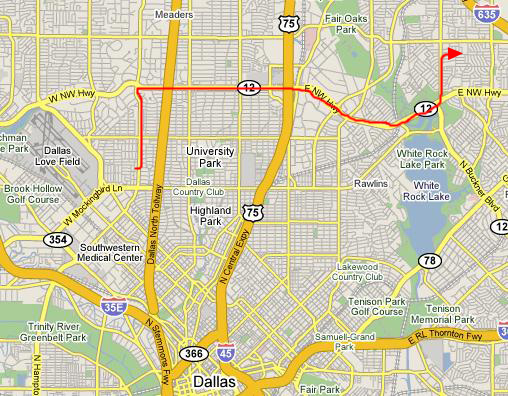 |
From the illustrative map at left, you can see where Mario and Steve live, relative to us and to the city itself. I have also marked one of the common routes to get from my house to theirs. They live in northeast Dallas, in an area known as Lake Highlands, because it occupies the high ground northeast of White Rock Lake. They are in a very nice neighborhood just east of Audelia Road and just south of Walnut Hill Lane.
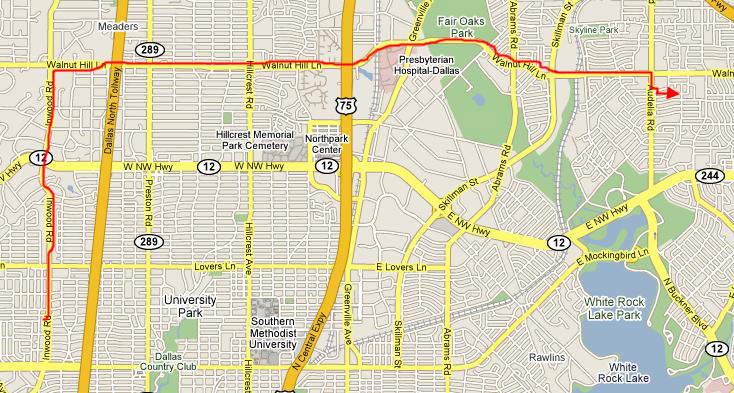 |
The route I marked above, the one that uses Northwest Highway, is fine in the evening, but, during the day, Northwest Highway carries a lot of traffic, since there are three major shopping areas along it. It can take quite a while to cross town on Northwest Highway at these peak traffic times.
At those times, it is better to go another mile north on Inwood and use Walnut Hill Lane. Walnut Hill has no shopping along it, and the only congestion is encountered when it goes underneath Central Expressway. But for the rest of its distance, it is just a four-lane arterial street (and there is only one school zone from Inwood to Audelia).
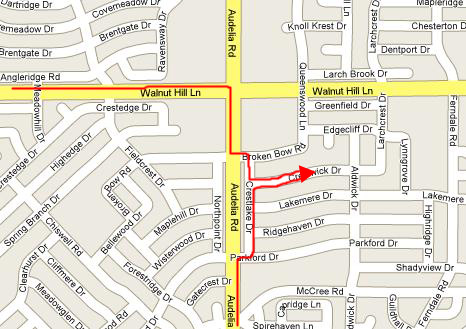 |
Coming from Walnut Hill Lane means you are coming down Audelia, so it's a left turn onto Broken Bow, a right turn onto Crestlake and a final left turn onto Crestwick.
So, getting to their house is pretty easy either way you go; it is about a twenty-minute trip.
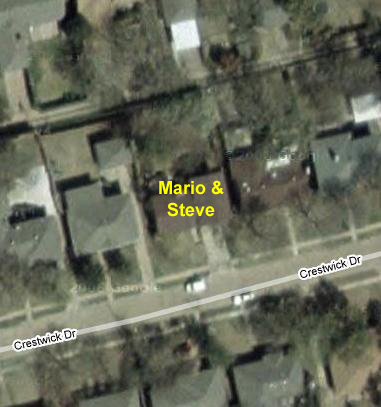 |
This is one of the many Dallas neighborhoods where there are alleys behind the houses running through the middle of each block. Some houses have their garage access off the alley, but just a few of them of garage access from the street, and Mario and Steve's house is one such. From their back porch, the yard slopes downward to that alley and the houses on the next street, so they have nice views from the back of their house, particularly from the upstairs bedrooms.
Courtesy of Google Street View, here is Mario and Steve's house. (Google has even relieved me of the necessity of taking my own picture of their house, although I may take some at a later date.)
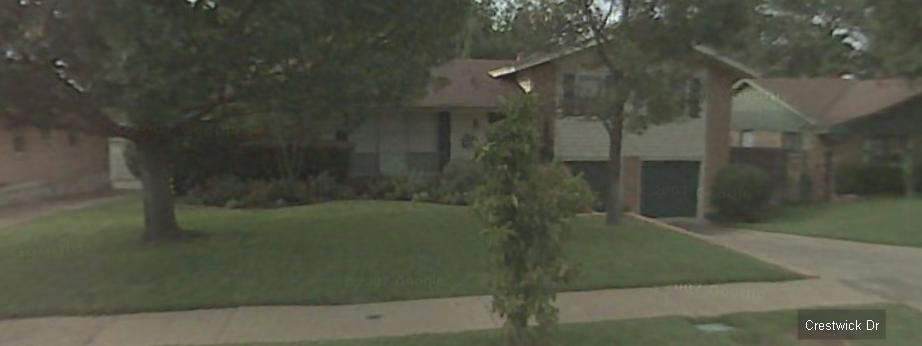 |
As you can see, the two-car garage is underneath the bedrooms at the top level of the split level layout. The intermediate level has the dining area, kitchen and living room. Up the half stairs there are three bedrooms and two bathrooms. Steve has one bedroom, Mario another and the third is used as an office/library.
Down the stairs from the intermediate level you reach a room that is "behind" the garage as you are looking at this picture, and this room has the garage access from inside the house. It is a very small room with a little powder room at the back. Mario uses it for his huge collection of CDs.
Anyway, that will about describe Mario and Steve's house for you.
Getting to the Heard Museum in McKinney
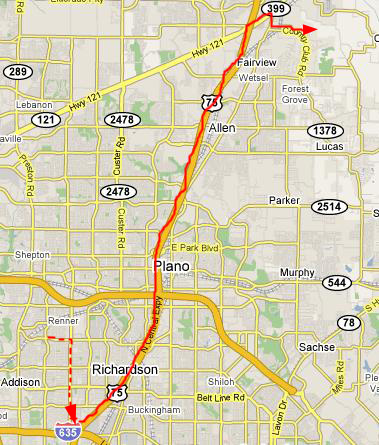 |
Our plan was to meet up somewhere so we could ride together up to the Museum. Since we were also going to a movie after our museum visit, and since the movie was going to be at the Regal Cinema near the interchange between US-75 and I-635, I drove down there when I was done at my Mom's and parked my car in the theatre parking lot.
The other guys showed up a few minutes later, picked me up, and we got back on US-75 going north. Just south of McKinney, we left the expressway to find the Heard Museum.
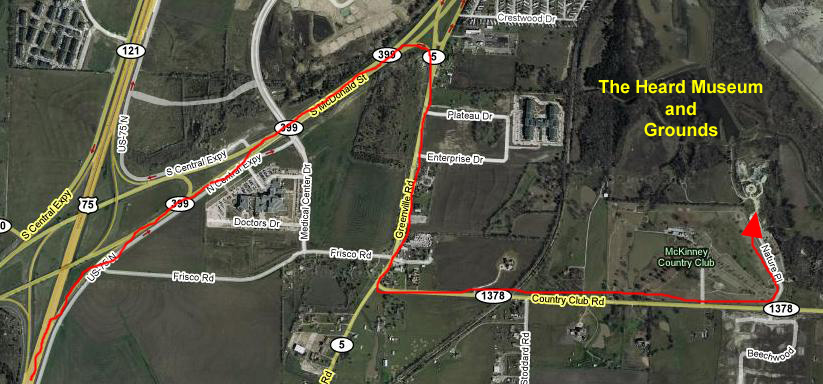 |
A mile or so south of the 399/5 intersection we came to FM 1378, which we took east past the country club to Nature Place and onto the museum grounds.
Looking at this aerial view now, I can see that there is a good shortcut to get to the museum from Dallas which involves getting off US-75 on the service road (avoiding any traffic tie-ups at the 121 interchange, and then going south of the medical center on Frisco Road. This would have been a lot better way to go.
But, be that as it may, we got to the Heard Museum about one-thirty in the afternoon.
Our Visit to the Heard Museum
History of the Heard Museum
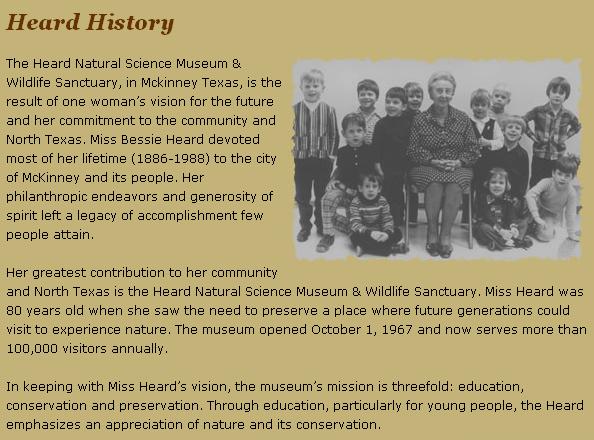
Dinosaurs Alive!
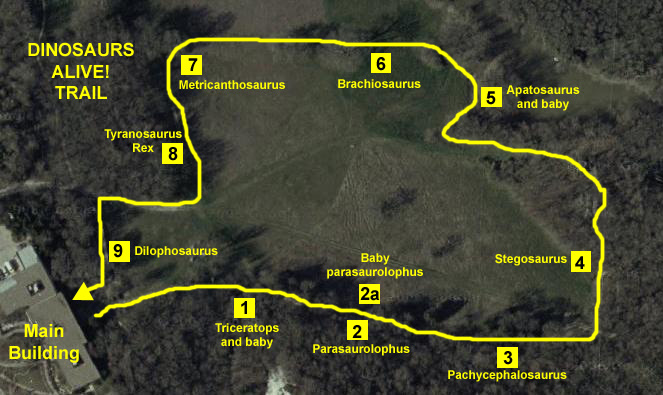
What I want to do is organize all the pictures that Fred and I took of the trail and the dinosaurs and key them to the trail map above. That way, you can get a good idea of what the exhibit was like. I also took pictures of each of the informational signs for each dinosaur, and I will include them in the section for that dinosaur.
So, we began our "dinosaur encounter" by leaving the main building, walking down the ramps and heading out to the start of the "Dinosaurs Alive!" trail.
Triceratops and Baby (1)
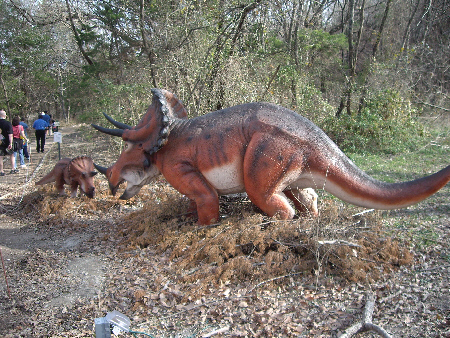 |
The Triceratops and Baby were our first stop on the trail. One of the interesting things about this exhibit, as opposed to other dinosaur models one might see is that these are animatronic. That is, they move and make sounds. They are controlled by an air pump (that was not always so well hidden) and have a speaker and recorded sounds. The only way to appreciate this aspect of these dinosaur models is to watch a movie.
|
|
We took some other pictures here at Triceratops. In one picture, you can see the Triceratops and baby as viewed from the side and in another picture you can see a close-up view of the Triceratops' head. Finally, in true tourist fashion, here are myself, Mario and Steve standing in front of the Triceratops.
Parasaurolophus (2) and Baby (2a)
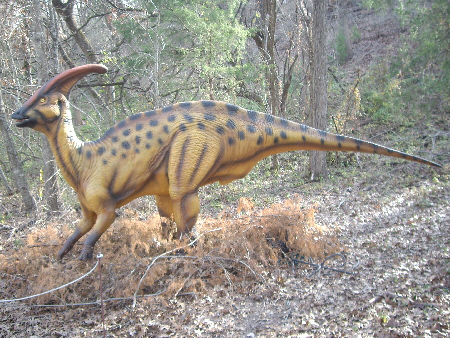 |
I had actually never heard of a Parasaurolophus before, but it was the second stop on the trail. This dinosaur roamed Western North America beginning 145 million years ago, but died out with the rest of the dinosaurs about 65 million years ago. Although they were large (about 6000 pounds each), they were herbivores. But I still wouldn't want to come across either an adult or a baby without a clear escape route.
Pachycephalosaurus (3)
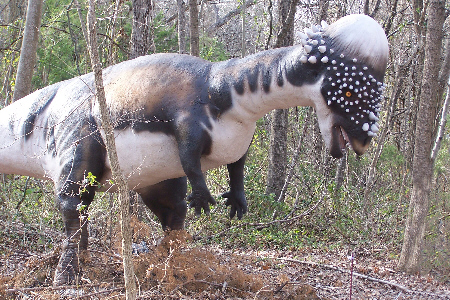 |
The Pachycephalosaurus was the third stop on the trail and, once again, I encounterd a dinosaur whose name I had not heard before. The name means "thick-headed lizard," and that certainly applied here as the skull of this dinosaur was almost a foot thick- much like today's sheep. This was a small dinosaur, only about 4000 pounds, and it also roamed the Western North American continent.
Fred got a very good picture of the Pachycephalosaurus and I, and I got a picture of Fred, Steve and Mario standing in front of it.
Stegosaurus (4)
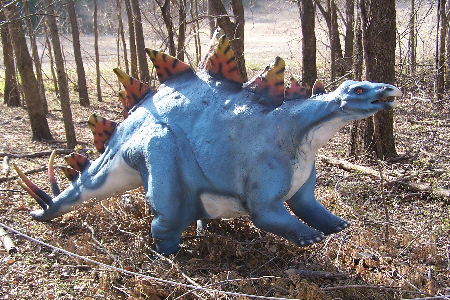 |
The Stegosaurus as our fourth stop on the trail, and is one of the dinosaurs that is familiar to most people, probably due to the upstanding plates along its spine. It's actually hard to understand what purpose the plates might have served, except to make the animal look larger or more well-protected. This dinosaur appeared earlier (205 million years ago) and also died out earlier (about 145 million years ago). The primary roaming area of this 2-ton dinosaur was the Western North American Continent.
Here are Steve, Mario and I in front of the Stegosaurus.
Apatosaurus and Baby (5)
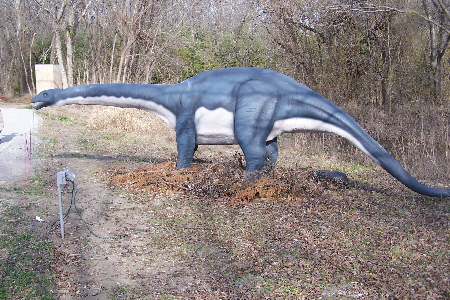 |
The fifth stop on our dinosaur trail tour was the Apatosaurus. Actually, the adult dinosaur was on one side of the path while its baby was on the other side.
For some reason, the name of this dinosaur means "deceptive lizard," but why that is the case I don't know. This was the largest of the dinosaurs we've encountered so far on the trail, coming in at 75 feet tall and 60,000 pounds in weight. This dinosaur also roamed Western North America, feeding on plants. This dinosaur, like some of the other plant eaters, had a very long neck, and that's why it had a long tail as well- as a counterbalance.
I took one other picture you might want to look at- one of the baby Apatosaurus.
|
|
Brachiosaurus (6)
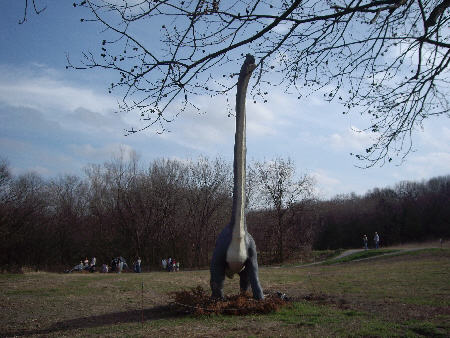 |
The sixth stop on our dinosaur trail tour was the Brachiosaurus. This dinosaur was the largest of those along the dinosaur trail; when fully grown, it reached 85 feet in length, 26 feet in height and weighted over 35 tons. It was one of the earlier dinosaurs, roaming most of the world during the Jurassic Period, between 205 and 145 million years ago. It was a plant eater, and with its long neck and forelimbs longer than its hind limbs, could reach the tops of most trees. Here is an excellent side view of the Brachiosaurus.
While that picture was a good one, we got an even better view as we walked a ways along the path. Looking back, we could easily imagine we were watching a live dinosaur feeding on the treetops.
Metricanthosaurus (7)
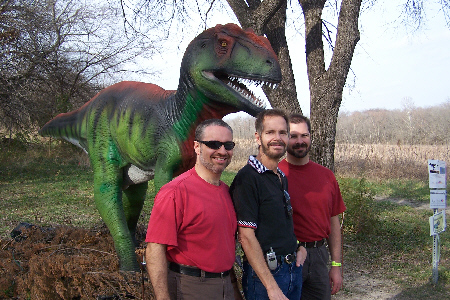 |
The seventh dinosaur along the "Dinosaurs Alive!" trail was the Metricanthosaurus. This dinosaur, which roamed Europe during the Jurassic Period was only moderately large- about 30 feet long and about 2000 pounds in weight. It was a carnivore, easy to imagine looking at its teeth.
Both Fred and I took pictures of the rest of the group in front of the Metricanthosaurus. You can see the picture that Fred took here, and you can see my picture here.
Tyrannosaurus Rex (8)
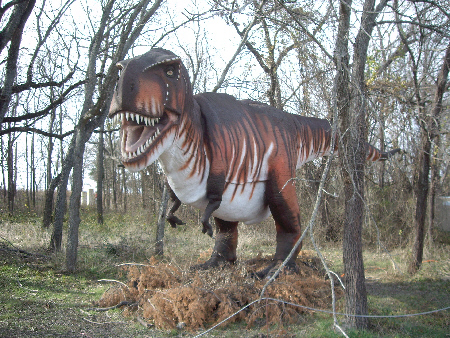 |
The next-to-last stop on our dinosaur trail tour was the most impressive example of them all- the Tyrannosaurus Rex. This is the dinosaur that has had the most PR, and is probably known to almost everyone by name. The name, incidentally, means "tyrant lizard," undoubtedly because of its occupying the top of the food chain. It wasn't the biggest dinosaur by any means- just 50 feet long and only 7 tons- but it was certainly among the most ferocious.
Tyrannosaurus roamed Northern North America and Central Asia, based on fossils that have been found, and it ruled the Late Cretaceous Period, up until the dinosaur die-off 65 million years ago. You can't exactly tell from the model or from the photographs, but the actual dinosaur had curved, serrated teeth that were longer than a human hand! The way the dinosaur was sculpted and posed along the trail led me inevitably to try to compose a picture that would capture what it might have been like had humans run into one of these creatures in the Cretaceous forest. I think the result turned out well, and is actually pretty funny; you can look at the picture here.
Fred took a number of other pictures of the Tyrannosaurus Rex, and I think all of them are quite good and present different views of the animal model. I hope you will click on the thumbnails below to look at these full-size pictures.
|
Dilophosaurus (9)
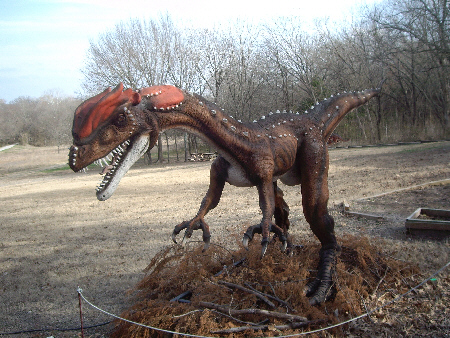 |
The last stop on our dinosaur trail tour was the Dilophosaurus. This was one of the dinosaurs that had some animatronics built into it, but the extent of the animation was to cause the dinosaur to "spit" a cloud of steam at unsuspecting visitors (mostly kids). Fred did take a movie to try to capture this dinosaur in action, but was unsuccessful in capturing the movement.
This dinosaur also roamed Western North America, but was relatively small- about 20 feet long, the height of a human being and weighing about 1000 pounds. It existed during the Jurassic Period, dying out some 145 million years ago.
This was the end of the dinosaur trail, and so we walked up the end of the trail to the main building. Just before we re-entered the museum, Fred looked back to get one more view of Dilophosaurus.
|
|
The Bluestem Trail
|
Our first trail was the Bluestem Trail, and I have marked this portion of our walk on the Heard Nature Preserve trail map at the left with a yellow line paralleling the section of the trail we were on.
Just a short ways from the museum buildings, right after the trail began, we passed the Raptors of Texas exhibit, which turned out to be closed. The sign said that the Heard had "applied for the permits to re-open the raptor houses," but I have no idea why they might have lost their "permit" or why they might need one. In any event, all the aviaries were empty.
The Bluestem Trail was about a half-mile, but there was not much to see along it. Fred did look back and get a picture of me talking to Mario.
The Wood Duck Trail
|
A short distance later, the boardwalk trail began, and Fred stopped us to take a picture. From here, the trail led along the raised boardwalk that went maybe a hundred feet out into the lake and then turned to basically parallel the shore. There were lots of twists and turns, making the raised boardwalk fun to walk along. A lot of effort must have gone into building it.
There were two or three places where we would come to an intersection, with one path of the boardwalk heading maybe another forty or fifty feet out into the lake where it just came to an end. I wasn't quite sure why these spurs had been constructed, but, when we could, we walked out to the end of them to have a look. Here is Fred at the end of a spur trail along the Wood Duck Trail boardwalk.
Between the boardwalk and the shore the water was not very deep, and there were lots of fallen logs and such, and on many of them Steve and Fred spied lots of turtles that were resting on top of the larger logs.
Walking along the boardwalk was enjoyable, even if there wasn't much sun. Fred and I took quite a few pictures, and I have put thumbnails for some of them below. Just click on the thumbnails to view the full-sized pictures:
|
Eventually, the boardwalk came back to shore and turned into an improved path again as we traversed a meadow back to the starting point at the pavilion. When we got there, we went up into the pavilion, which was reminiscent of the tower at Gumbo Limbo in Boca Raton except not so high. Here aree Steve, Mario and Fred on the second floor of the pavilion. The pavilion is right beside another small lake, and there was a dock leading out into the lake, so I took a walk out on it, turning back to see the guys and the pavilion back on shore.
Well, that was about it for the Heard Museum and Nature Center. We walked back to main building where Fred and I toured the museum portion of the build while Steve and Mario waited for us outside. The museum was quite interesting- lots of live animals (snakes and stuff like that) and lots and lots of fossils. I enjoyed the walk through the museum and our time here at the Heard.
We Visit Downtown McKinney
We had some time before our movie, so Fred directed Steve the short distance from the Heard to old downtown McKinney and The Square. Like many Texas towns, the center of the main square is where the courthouse is located. We walked around for a while, but only got a chance to stop into a couple of stores as everything was closing for the day.
Then it was back down to Dallas for a movie and dinner.
You can use the links below to continue to another photo album page.
 |
January 19, 2008: Watching Joe Nichols at Billy Bob's Texas |
 |
Return to Index for 2008 |